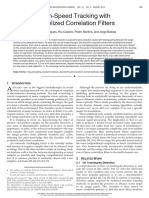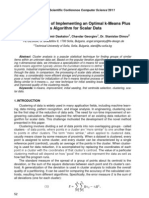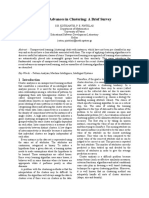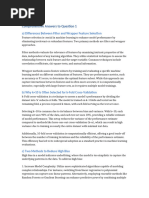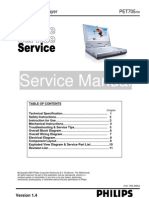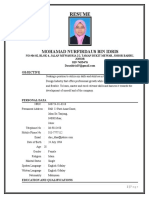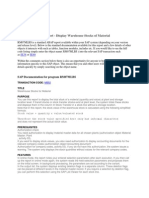0 ratings0% found this document useful (0 votes)
55 viewsDepso Model For Efficient Clustering Using Drifting Concepts.
Depso Model For Efficient Clustering Using Drifting Concepts.
Uploaded by
Dr J S KanchanaData mining is the procedure of mining knowledge from data. The information or knowledge extracted so can be used for Market Analysis, Customer Reten-tion. As a data mining function, cluster analysis serves as a tool to gain insight into the distribution of data to observe characteristics of each cluster. Clustering is the process of making a group of abstract objects into classes of similar objects. An Existing system uses itera-tive optimization algorithm for clustering the data objects with d
Copyright:
© All Rights Reserved
Available Formats
Download as DOC, PDF, TXT or read online from Scribd
Depso Model For Efficient Clustering Using Drifting Concepts.
Depso Model For Efficient Clustering Using Drifting Concepts.
Uploaded by
Dr J S Kanchana0 ratings0% found this document useful (0 votes)
55 views5 pagesData mining is the procedure of mining knowledge from data. The information or knowledge extracted so can be used for Market Analysis, Customer Reten-tion. As a data mining function, cluster analysis serves as a tool to gain insight into the distribution of data to observe characteristics of each cluster. Clustering is the process of making a group of abstract objects into classes of similar objects. An Existing system uses itera-tive optimization algorithm for clustering the data objects with d
Original Title
DEPSO MODEL FOR EFFICIENT CLUSTERING USING DRIFTING CONCEPTS.
Copyright
© © All Rights Reserved
Available Formats
DOC, PDF, TXT or read online from Scribd
Share this document
Did you find this document useful?
Is this content inappropriate?
Data mining is the procedure of mining knowledge from data. The information or knowledge extracted so can be used for Market Analysis, Customer Reten-tion. As a data mining function, cluster analysis serves as a tool to gain insight into the distribution of data to observe characteristics of each cluster. Clustering is the process of making a group of abstract objects into classes of similar objects. An Existing system uses itera-tive optimization algorithm for clustering the data objects with d
Copyright:
© All Rights Reserved
Available Formats
Download as DOC, PDF, TXT or read online from Scribd
Download as doc, pdf, or txt
0 ratings0% found this document useful (0 votes)
55 views5 pagesDepso Model For Efficient Clustering Using Drifting Concepts.
Depso Model For Efficient Clustering Using Drifting Concepts.
Uploaded by
Dr J S KanchanaData mining is the procedure of mining knowledge from data. The information or knowledge extracted so can be used for Market Analysis, Customer Reten-tion. As a data mining function, cluster analysis serves as a tool to gain insight into the distribution of data to observe characteristics of each cluster. Clustering is the process of making a group of abstract objects into classes of similar objects. An Existing system uses itera-tive optimization algorithm for clustering the data objects with d
Copyright:
© All Rights Reserved
Available Formats
Download as DOC, PDF, TXT or read online from Scribd
Download as doc, pdf, or txt
You are on page 1of 5
DEPSO MODEL FOR EFFICIENT CLUSTERING USING DRIFTING CONCEPTS.
Dr. J.S.Kanchana1, Dr.N.Rajathi2
1
Department of Information Technology, K.L.N. College of Engineering, Pottapalayam, Tamil Nadu, India
2
Department of Information Technology, Kumaraguru College of Technology Coimbatore, Tamil Nadu, India
Abstract
Data mining is the procedure of mining automated, prospective tools typical of
knowledge from data. The information decision support systems. Data mining
or knowledge extracted so can be used tools can answer business questions that
for Market Analysis, Customer traditionally were too time consuming to
Retention. As a data mining function, resolve. The techniques can be
cluster analysis serves as a tool to gain implemented rapidly on existing software
insight into the distribution of data to and hardware platforms to enhance the
observe characteristics of each cluster. value of existing information-resources,
Clustering is the process of making a and can be integrated with new products
group of abstract objects into classes of and systems as they are brought on-line.
similar objects. An Existing system uses The objective of clustering is to
iterative optimization algorithm for grouping similar data items into clusters so
clustering the data objects with drifting that items in the same cluster have high
concepts using some cluster validity similarity but are dissimilar with item in
function to evaluate the effectiveness of other clusters. The process of clustering
the clustering model while each new the entire dataset without performing
input data subset is flowing. The drifting concepts are in considered. Such
Proposed system uses Differential process is not only decreasing the quality
Evolutionary Particle Swarm of the cluster but also disregards the
Optimization (DEPSO) model for expectations of user that they need only
effectively clustering the several real the recent clustering result. The volume of
data sets with drifting concepts. data stream is huge so storing and taking
the entire data stream is expensive.
Keywords: Cluster analysis, Differential Therefore, well defined technique is used
evolutionary, Particle Swarm Optimization, for effectively and efficiently clustering
Drifting Concepts
dataset with drifting concepts. In this paper
we use differential evolutionary particle
1 INTRODUCTION swarm optimization algorithm for
clustering the dataset with drifting
Today’s data mining, it is helpful for concepts.
the extraction of hidden predictive
information from large databases, it is an
powerful new technology with great 2. RELATED WORK:
potential to help companies focus on the
most important in their data warehouses. Liang Bai [3] in “An optimization
Data mining tools predict future trends and model for clustering categorical data
behaviors, allowing business to make streams with drifting concepts” had
proactive. knowledge based decisions. The observed that there is always a lack of a
2
cluster validity function and optimization without having to look at every point that
strategy to find out clusters and catch the has been clustered so far.
evolution trend of cluster structures on a
categorical data stream. Therefore, this Fuyuan Cao in “A new initialization
paper presents an optimization model for method for categorical data clustering” has
clustering categorical data streams. An revealed that a novel initialization method
iterative optimization algorithm is for categorical data is proposed, in which
proposed to solve an optimal solution of the distance between objects and the
the objective function with some density of the object is considered. We also
constraints. apply the proposed initialization method to
Hung-Leng Chen in “Catching the trend: k-modes algorithm and fuzzy k-modes
A framework for clustering concept- algorithm.
drifting categorical data” has revealed that
sampling has been recognized as an
important technique to improve the
efficiency of clustering. Mechanism 3. PROPOSED WORK:
named Maximal Resemblance Data
Labeling (abbreviated as MARDL) is 3.1. BLOCK DIAGRAM
proposed to allocate each unlabeled data
point into the corresponding appropriate The block diagram of the proposed
cluster based on the novel categorical system is presented in figure 1.
clustering representative, namely, N-Node
set Importance
Representative(abbreviated as NNIR),
which represents clusters by the
importance of the combinations of
attribute values.
Fuyuan Caoin in “A framework for
clustering categorical time-evolving data”
had observed that, the problem of
clustering categorical time-evolving data
remains as a challenging issue. In this
paper, we propose a generalized clustering
framework for categorical time-evolving
data. The time-complexity analysis
indicates that these proposed algorithms
are effective for large datasets.
Daniel Barbara in “COOLCAT: An
entropy-based algorithm for categorical
“had investigated COOLCAT is well
equipped to deal with clustering of data
streams (continuously arriving streams of
data point) since it is an incremental Fig 1. Working of the Proposed System
algorithm capable of clustering new points
7
3.2. CLUSTERING FRAMEWORK in the construction of the new clustering
model. In the case, we need to re-cluster
In order to cluster categorical data the new input data subset. we consider the
streams and detect the drifting concepts, following two factors to find out the
we apply a clustering framework based on drifting concepts such as distribution
the sliding window technique. The sliding variation and certainty variation.
window technique conveniently eliminates The distribution variation may reduce
the outdated records and only saves the or enhance the uncertainty of the
clustering models, which is utilized in clustering model for cluster
several previous works on clustering time- representatives. If the uncertainty is
evolving data. Therefore, based on the reduced, it is thought that the concepts do
technique, we can cluster the latest data not drift, although the distribution
objects in the current window and catch variation is large.
the evolution trend of cluster structures on
the data stream. The different partition
results maybe lead to the different 3.5. CLUSTERING ACCURACY
detection results of drifting concepts. EVALUATION
Therefore, we need the optimization model
to find out the optimal partition result for To evaluate the performance of
the new input data subset. clustering algorithms in the experiment,
we consider the three validity measures
3.3. DEPSO ALGORITHM accuracy, precision and recall and the
formulas are as follows
DE-PSO starts like the usual DE 1) accuracy(AC)
algorithm up to the point where the trial
vector is generated. If the trial vector
2) precision (PE)
satisfies the conditions, then it is included
in the population otherwise the algorithm
enters the PSO phase and generates a new
3) recall (RE)
candidate solution. The method is repeated
iteratively till the optimum value is RE=
reached. The inclusion of PSO phase
creates a perturbation in the population,
which in turn helps in maintaining 4. EXPERIMENTAL SETUP
diversity of the population and producing a
good optimal solution. Here we can use KDD-CUP’99 data
stream for our experiment. Table 1 shows
3.4. THE DRIFTING CONCEPT the computational times against the
DETECTION numbers of clusters. According to the
After clustering new input data table, the DEPSO algorithm requires more
subsets, we need to analyze the change computational times than iterative
situation between the new and last algorithms.
clustering models, in order to determine
whether the drifting concepts occur. While
the concepts have drifted, the last
clustering model is not used to participate
4
effectively clustering with drifting
No. of Iterative DEPSO concepts was presented. Finally, the
Iteration Algorithm Algorithm performance of the proposed algorithm is
tested and the experimental results have
5 169.12 172.7 shown that the proposed algorithm is
effective in clustering the data streams and
10 256.88 262.34
the detection results based on the proposed
15 371.69 385.52 method are reliable. This work has a very
vast scope in future and it can be
20 458.69 467.21 implemented on other new heuristic
algorithms in future. It can be updated in
Table 1. Computational Times (Seconds) near future as and when requirement for
of Clustering Algorithms for Different the same arises, as it is very flexible in
Numbers of Clusters terms of efficiency.
The figure 2 shows the computational
time of iterative algorithm and DEPSO REFERENCES
algorithm for different number of clusters.
The DEPSO algorithm shows the better [1] Liang Bai, Xueqi Cheng, Member,
computational time when compared with IEEE, Jiye Liang, and Huawei Shen., “An
iterative algorithm. Optimization Model for Clustering
Categorical Data Streams with Drifting
Concepts”, IEEE Transactions on
Knowledge and Data Engineering, Vol.
28 , Issue. 11, Nov. 2016.
[2] L. Bai, J. Liang, C. Dang, and F.
Cao, “The impact of cluster
representatives on the convergence of the
K-modes type clustering,” IEEE Trans.
Pattern Anal. Mach. Intell., vol. 35, no. 6,
pp. 1509– 1522, Jun. 2013.
[3] L. Bai, J. Liang, and C. Dang, “An
initialization method to simultaneously
find initial cluster centers and the number
of clusters for clustering categorical data,”
Knowl.-Based Syst., vol. 24, no. 6, pp.
Fig.2. Computational Times (Seconds) of 785–795, 2011.
Clustering Algorithms for Different [4] S. Ho and H. Wechsler, “A
Numbers of Clusters martingale framework for detecting
changes in data streams by testing
exchangeability,” IEEE Trans. Pattern
5. CONCLUSION Anal. Mach. Intell., vol. 32, no. 20, pp.
2113–2127, Dec 2010.
In this paper, Differential evolutionary [5] F. Cao, J. Liang, and L. Bai, “A
particle swarm optimization algorithm for framework for clustering categorical time-
7
evolving data,” IEEE Trans. Fuzzy Syst.,
vol. 18, no. 5, pp. 872–885, Oct. 2010.
[6] K. Chen and L. Liu, “HE-tree: A
framework for detecting changes in
clustering structure for categorical data
streams,” Int. J. Very Large Data Bases,
vol. 18, no. 5, pp. 1241–1260, 2009.
[7] H. Chen, M. Chen, and S. Lin,
“Catching the trend: A framework for
clustering concept-drifting categorical
data,” IEEE Trans. Knowl. Data Eng., vol.
21, no. 5, pp. 652–665, May 2009.
You might also like
- Sound Source Ion Using LabVIEWDocument63 pagesSound Source Ion Using LabVIEWSusheela Sushe NNo ratings yet
- Paper-2 Clustering Algorithms in Data Mining A ReviewDocument7 pagesPaper-2 Clustering Algorithms in Data Mining A ReviewRachel WheelerNo ratings yet
- A Fast Clustering Algorithm To Cluster Very Large Categorical Data Sets in Data MiningDocument13 pagesA Fast Clustering Algorithm To Cluster Very Large Categorical Data Sets in Data MiningSunny NguyenNo ratings yet
- Machine Learning with Clustering: A Visual Guide for Beginners with Examples in PythonFrom EverandMachine Learning with Clustering: A Visual Guide for Beginners with Examples in PythonNo ratings yet
- User Guide S800 I-ODocument432 pagesUser Guide S800 I-OMarcelo OliveiraNo ratings yet
- Pam Clustering Technique: Bachelor of Technology Computer Science and EngineeringDocument11 pagesPam Clustering Technique: Bachelor of Technology Computer Science and EngineeringsamakshNo ratings yet
- A New Method For Dimensionality Reduction Using K-Means Clustering Algorithm For High Dimensional Data SetDocument6 pagesA New Method For Dimensionality Reduction Using K-Means Clustering Algorithm For High Dimensional Data SetM MediaNo ratings yet
- Recursive Hierarchical Clustering AlgorithmDocument7 pagesRecursive Hierarchical Clustering Algorithmreader29No ratings yet
- 1 s2.0 S0031320311005188 MainDocument15 pages1 s2.0 S0031320311005188 MainRohhan RabariNo ratings yet
- A Fast DBSCAN Algorithm for Big Data Based on Efficient DensityDocument12 pagesA Fast DBSCAN Algorithm for Big Data Based on Efficient DensityTejasNo ratings yet
- OPTICS: Ordering Points To Identify The Clustering StructureDocument12 pagesOPTICS: Ordering Points To Identify The Clustering StructureqoberifNo ratings yet
- 6 - A - Robust - Dynamic - Niching - Genetic - Algorithm - With - Niche - Migration - For - Automatic - Clustering - Problem 2010Document15 pages6 - A - Robust - Dynamic - Niching - Genetic - Algorithm - With - Niche - Migration - For - Automatic - Clustering - Problem 2010yuvicena940No ratings yet
- Comparative Study of K-Means and Hierarchical Clustering TechniquesDocument7 pagesComparative Study of K-Means and Hierarchical Clustering TechniquesMagdalena PalomaresNo ratings yet
- Hierarchical Clustering PDFDocument5 pagesHierarchical Clustering PDFLikitha ReddyNo ratings yet
- Comparison of Graph Clustering AlgorithmsDocument6 pagesComparison of Graph Clustering AlgorithmsseventhsensegroupNo ratings yet
- Impact of Outlier Removal and Normalization ApproaDocument6 pagesImpact of Outlier Removal and Normalization ApproaPoojaNo ratings yet
- Automatic Clustering Using An Improved Differential Evolution AlgorithmDocument20 pagesAutomatic Clustering Using An Improved Differential Evolution Algorithmavinash223No ratings yet
- Evolving Fuzzy ModelDocument9 pagesEvolving Fuzzy ModelKệ ThôiNo ratings yet
- Implement A Mining Web Document Through New Data Clustering Algorithm PDFDocument7 pagesImplement A Mining Web Document Through New Data Clustering Algorithm PDFeditor_ijcatNo ratings yet
- Gautam A. KudaleDocument6 pagesGautam A. KudaleHellbuster45No ratings yet
- Efficient Data Clustering With Link ApproachDocument8 pagesEfficient Data Clustering With Link ApproachseventhsensegroupNo ratings yet
- Applying SR-Tree Technique in DBSCAN Clustering AlgorithmDocument4 pagesApplying SR-Tree Technique in DBSCAN Clustering AlgorithmInternational Journal of Application or Innovation in Engineering & ManagementNo ratings yet
- High-Speed Tracking With Kernelized Correlation FiltersDocument14 pagesHigh-Speed Tracking With Kernelized Correlation FiltersKha DijaNo ratings yet
- Increased Performance Factor For The Best Clustering AlgorithmDocument3 pagesIncreased Performance Factor For The Best Clustering AlgorithmerpublicationNo ratings yet
- Clustering in Machine Learning - JavatpointDocument10 pagesClustering in Machine Learning - Javatpointmangotwin22No ratings yet
- Column-Store Decision Tree Classification of Unseen Attribute SetDocument5 pagesColumn-Store Decision Tree Classification of Unseen Attribute SetMaurice LeeNo ratings yet
- Ijcseit 020604Document9 pagesIjcseit 020604ijcseitNo ratings yet
- Enhancing The Exactness of K-Means Clustering Algorithm by CentroidsDocument7 pagesEnhancing The Exactness of K-Means Clustering Algorithm by CentroidserpublicationNo ratings yet
- GFJHFNDocument21 pagesGFJHFNÀnîsh JángîdNo ratings yet
- Visual Clustering ApproachesDocument3 pagesVisual Clustering ApproachesK V D SagarNo ratings yet
- Comparison of Different Clustering Algorithms Using WEKA ToolDocument3 pagesComparison of Different Clustering Algorithms Using WEKA ToolIJARTESNo ratings yet
- A Rapid Hybird Clustring Algorithm For A Large Volumes of HighDocument77 pagesA Rapid Hybird Clustring Algorithm For A Large Volumes of HighRenowntechnologies VisakhapatnamNo ratings yet
- 13238-Article Text-23626-1-10-20221220Document7 pages13238-Article Text-23626-1-10-20221220Harsh ThakkerNo ratings yet
- 10 1109icdim 2016 7829786Document11 pages10 1109icdim 2016 7829786junaidNo ratings yet
- A Comparison of K-Means Clustering Algorithm and CDocument4 pagesA Comparison of K-Means Clustering Algorithm and CLuis Antonio MAMANI ALAVENo ratings yet
- 5080-Article Text-17819-1-10-20230830Document6 pages5080-Article Text-17819-1-10-20230830Arif Mu'amar WahidNo ratings yet
- Slicing A New Approach To Privacy Preserving Data PublishingDocument19 pagesSlicing A New Approach To Privacy Preserving Data Publishingkeerthana1234No ratings yet
- Clustering Techniques and Their Applications in EngineeringDocument16 pagesClustering Techniques and Their Applications in EngineeringIgor Demetrio100% (1)
- Introduction To KEA-Means Algorithm For Web Document ClusteringDocument5 pagesIntroduction To KEA-Means Algorithm For Web Document Clusteringsurendiran123No ratings yet
- An Improvement in K Means Clustering Algorithm IJERTV2IS1385Document6 pagesAn Improvement in K Means Clustering Algorithm IJERTV2IS1385David MorenoNo ratings yet
- A Novel Approach of Implementing An Optimal K-Means Plus Plus Algorithm For Scalar DataDocument6 pagesA Novel Approach of Implementing An Optimal K-Means Plus Plus Algorithm For Scalar DatasinigerskyNo ratings yet
- +A Distribution-Aware Training Scheme For Learned IndexesDocument15 pages+A Distribution-Aware Training Scheme For Learned IndexesaaarashNo ratings yet
- A_Novel_Drift_Detection_Algorithm_BasedDocument12 pagesA_Novel_Drift_Detection_Algorithm_Basedmssvr57ky4No ratings yet
- Multilevel Techniques For The Clustering ProblemDocument15 pagesMultilevel Techniques For The Clustering ProblemCS & ITNo ratings yet
- Spectral Clustering Via Ensemble Deep AutoencoderDocument33 pagesSpectral Clustering Via Ensemble Deep AutoencoderDuy PhamNo ratings yet
- Recent Advances in Clustering A Brief SurveyDocument9 pagesRecent Advances in Clustering A Brief SurveyAnwar ShahNo ratings yet
- Alternatives To The K-Means Algorithm That Find Better ClusteringsDocument8 pagesAlternatives To The K-Means Algorithm That Find Better ClusteringsDimitris IracleousNo ratings yet
- applsci-14-00715Document13 pagesapplsci-14-00715TejasNo ratings yet
- Research On K-Means Clustering Algorithm An Improved K-Means Clustering AlgorithmDocument5 pagesResearch On K-Means Clustering Algorithm An Improved K-Means Clustering AlgorithmSomu NaskarNo ratings yet
- KDD96 037Document6 pagesKDD96 037JulioMartinezNo ratings yet
- Question1 Answers CompleteDocument4 pagesQuestion1 Answers CompleteShreyansh JagtapNo ratings yet
- An Enhanced Clustering Algorithm To Analyze Spatial Data: Dr. Mahesh Kumar, Mr. Sachin YadavDocument3 pagesAn Enhanced Clustering Algorithm To Analyze Spatial Data: Dr. Mahesh Kumar, Mr. Sachin YadaverpublicationNo ratings yet
- Data Clustering Using Kernel BasedDocument6 pagesData Clustering Using Kernel BasedijitcajournalNo ratings yet
- AcedDocument17 pagesAcedNidhi SinghNo ratings yet
- Clustering Exercise 4-15-15Document2 pagesClustering Exercise 4-15-15nomore891No ratings yet
- JETIR1503025Document4 pagesJETIR1503025EdwardNo ratings yet
- Discovering Knowledge in Data: Lecture Review ofDocument20 pagesDiscovering Knowledge in Data: Lecture Review ofmofoelNo ratings yet
- Analysis and Study of Incremental DBSCAN Clustering AlgorithmDocument15 pagesAnalysis and Study of Incremental DBSCAN Clustering Algorithmadmin2146No ratings yet
- A New Decision Tree Learning Approach For Novel Class Detection in Concept Drifting Data Stream ClassificationDocument8 pagesA New Decision Tree Learning Approach For Novel Class Detection in Concept Drifting Data Stream ClassificationJournal of Computer Science and EngineeringNo ratings yet
- DWBI4Document10 pagesDWBI4Dhanraj DeoreNo ratings yet
- Python Machine Learning for Beginners: Unsupervised Learning, Clustering, and Dimensionality Reduction. Part 1From EverandPython Machine Learning for Beginners: Unsupervised Learning, Clustering, and Dimensionality Reduction. Part 1No ratings yet
- Offline Fe Training M SeriesDocument334 pagesOffline Fe Training M Seriesinteractive.ralmarezNo ratings yet
- Pet 705Document28 pagesPet 705api-3702225100% (3)
- Red Hat Gluster Storage 3.5 Administration Guide en USDocument492 pagesRed Hat Gluster Storage 3.5 Administration Guide en USDionis HernandezNo ratings yet
- Process of Delegation Signature Set Up - 28042019Document15 pagesProcess of Delegation Signature Set Up - 28042019rakesh1619No ratings yet
- Product Category Contracts Umoja Job AidDocument8 pagesProduct Category Contracts Umoja Job AidRafi RahimiNo ratings yet
- Equipos Oftalmologicos ComparacionDocument11 pagesEquipos Oftalmologicos ComparacionFrancisco GomezNo ratings yet
- Apple's Supply Chain Strategy: Hettiarachchi H.A.HDocument4 pagesApple's Supply Chain Strategy: Hettiarachchi H.A.HRetail Fashion Merchandising100% (1)
- Business Requirements Document (BRD) For Delivery SystemDocument5 pagesBusiness Requirements Document (BRD) For Delivery Systemmageserv.ltdNo ratings yet
- ComEXT ManualDocument560 pagesComEXT ManualrdjkxbjrnoqrgbayzaNo ratings yet
- An Ideal Comparator Compares Two Input Voltages and Produces A Logic Output Signal The Circuit Symbol For A Comparator Is Identical To The One For Op-AmpDocument20 pagesAn Ideal Comparator Compares Two Input Voltages and Produces A Logic Output Signal The Circuit Symbol For A Comparator Is Identical To The One For Op-AmpPuneeth SiddappaNo ratings yet
- Contoh ResumeDocument5 pagesContoh ResumeDaus IdrisNo ratings yet
- Bugs - A Verification Engineer's Dream, A Designer's NightmareDocument5 pagesBugs - A Verification Engineer's Dream, A Designer's NightmareSam HoneyNo ratings yet
- Explain Three Main Features of Active DirectoryDocument14 pagesExplain Three Main Features of Active DirectoryNavneetMishraNo ratings yet
- Sonia F Sap Fico ProjectDocument146 pagesSonia F Sap Fico ProjectSree VasNo ratings yet
- Questionnaire Section A (Bio. Data)Document3 pagesQuestionnaire Section A (Bio. Data)Muha Mmed Jib RilNo ratings yet
- Computer SimulationDocument314 pagesComputer SimulationSérgio Carvalho100% (1)
- Semaphores: Race Condition Problem. For Example, Two Processes Both IncrementDocument11 pagesSemaphores: Race Condition Problem. For Example, Two Processes Both IncrementManu RajNo ratings yet
- Induction Motor Design For Electric VehiclesDocument12 pagesInduction Motor Design For Electric Vehiclesmass72100% (1)
- DBMS Architecture: Database ModelsDocument6 pagesDBMS Architecture: Database Modelsraazoo19No ratings yet
- Recuperar Firmware UbiquitiDocument4 pagesRecuperar Firmware UbiquitiJose Daniel ChicaizaNo ratings yet
- RN Qts Pro Dev Support 683706 788208Document31 pagesRN Qts Pro Dev Support 683706 788208Ritesh DewanNo ratings yet
- Survey On Evolving Deep Learning Neural Network ArchitecturesDocument10 pagesSurvey On Evolving Deep Learning Neural Network ArchitecturesLuis Dominguez LeitonNo ratings yet
- Komfil 8th WeeksDocument27 pagesKomfil 8th WeeksJabez Dan CabuhatNo ratings yet
- PT 0817manila Room Assignment PDFDocument44 pagesPT 0817manila Room Assignment PDFPhilBoardResultsNo ratings yet
- JUE-250 Installation Manual 7ZPSC0258 - Ver4.0 PDFDocument83 pagesJUE-250 Installation Manual 7ZPSC0258 - Ver4.0 PDFPaul Robert PredoiNo ratings yet
- SAP MM Stock TablesDocument19 pagesSAP MM Stock TablesrksamplaNo ratings yet
- Oracle RAC On VMware VSANDocument37 pagesOracle RAC On VMware VSANShahulNo ratings yet
- LAPORAN HARI KE-1 TUGAS 1 Dan 2 PRAKTIKUM INTERNET OF THINGSDocument10 pagesLAPORAN HARI KE-1 TUGAS 1 Dan 2 PRAKTIKUM INTERNET OF THINGScaca dimasNo ratings yet























